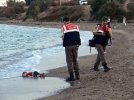piliangie said:
I don't know what exactly is going on, even reading the sessions transcripts, sometimes is confusing, I belong to latin America, and we are seeing things unexplicably, like the US militars arriving in PERU, and in Mexico, they allowed american police agents, wear an arm, guns' here in Mexico! things are getting very ugly...I don't like Americans anymore sorry for saying...I know theres a lot of many many good people in USA but this goverment is horrible. and the ignorant and arrogants racist people.......and here we have a very old problem , of refugees that come from south America to Mexico and want to go to the States, and US CITIZENS think that all of them are mexicans...they are so wrong....North America oringinates troubles in this countrys, and later they put down inmigrants also,disregard them, like filthy people...and don't understand that They are part of the problem also....and now! is happening in all around the world....
The problem with us, and citizens from whatever country, is our ignorance, I understand when you say about americans, because I used to think that way, I remember chanting slogans against americans back in 91 when the US attacked Irak, I was in high school in a march against the war, and certainly did not discriminate between those who took the decision (psychopaths in power) and citizens at large. It helps to learn to differentiate, because one thing are the citizens from US and the other is their government, and they, US citizens, are too being subjugated by their government, although many had not acknowledge yet. Yes, there are racists there, but also here in Mexico in many ways, and I assume that racism exists in Latin America as well.
piliangie?, can you differentiate between a Chinese, Japanese, Korean, Philippine, or Mongolian??, personally I think I may not be able, though. It occurred me to think, that many Americans may confuse between a Nicaraguan from a Mexican because their physiognomy and economic situation (poor and miserable) is similar as well. But this confusion is aggravated by our poor education that had taught us to be above others.
Fleeing from their country because life as they have is beyond intolerable, that's why thousands of alone children went to US http://www.sott.net/article/280841-Welcome-to-America-Human-rights-crisis-at-US-Border-detention-centers ... and I do not think the influx stop much, even with the US border propaganda's song, though. Even when there seems to not be new news about it, it does not mean that it had stopped. Bad news keep overlapping through the passing months.
_http://www.theguardian.com/world/shortcuts/2014/jul/16/la-bestia-song-commissioned-us-border-control-stop-immigration said:
It might just be the most tuneful piece of propaganda since The Simpsons' "Drop Da Bomb". La Bestia, "the beast", mimics the traditional Mexican narrative ballads called "corridos". With catchy Caribbean-style instrumentation, it tells the story of "the Beast from the South, this wretched train of death", a notoriously dangerous freight train on which migrants hitch a lift to the United States. It is currently being played on 21 radio stations in Central America. But what listeners are not being told is that the song was devised by a US advertising agency, for US Customs and Border Protection, as part of a multi-million dollar anti-immigration campaign to halt the influx of migrants from Honduras, Guatemala and El Salvador.
Migra corridos – migra is a derogatory term for US immigration officials – have been around for a few years. In 1998, the US Border Patrol made public service announcements to warn potential migrants of the danger of crossing the border and commissioned an advertising agency to compose tragic songs such as El Más Grande Enemigo about fatal crossings in the tradition of the narco corridos, the melodramatic ballads about Mexico's drug lords.
_https://www.youtube.com/watch?v=IGimonYeqsk --- "La Bestia" song.
What gets me angry is that at the msm, keep saying that the influx is due to Syria civil war, and I find myself replaying at the TV/radio that is not, that psychopaths in power that call themselves governments, keep beating, bombing, bothering a country that do not had payed tribute to them. and I do not think they take responsibility any time soon.
But, I read the article below about the doings of people with conscience, and that's good news, between all of the wrongs that are in the world, is good to know about this also.
http://www.sott.net/article/301175-Regime-change-refugees-On-the-shores-of-Europe said:
There is also the people's ethics - banners in Germany unfurled at football games to welcome refugees, convoys of ordinary British nations to Calais (France) to help feed and clothe the refugees, demonstrations of radical internationalists in Eastern Europe against the neo-fascists and the racists. There are also, in the United States, the Dream Defenders and United We Dream who fight for undocumented residents, who formed part of the massive pro-immigrant rallies that have now adopted May Day as their day. These indications of the good side of history are often ignored by the press, which has a tendency to hype up the bad side to boost ratings. Such gestures of solidarity tell us what is possible in the West.




